The Home Guard
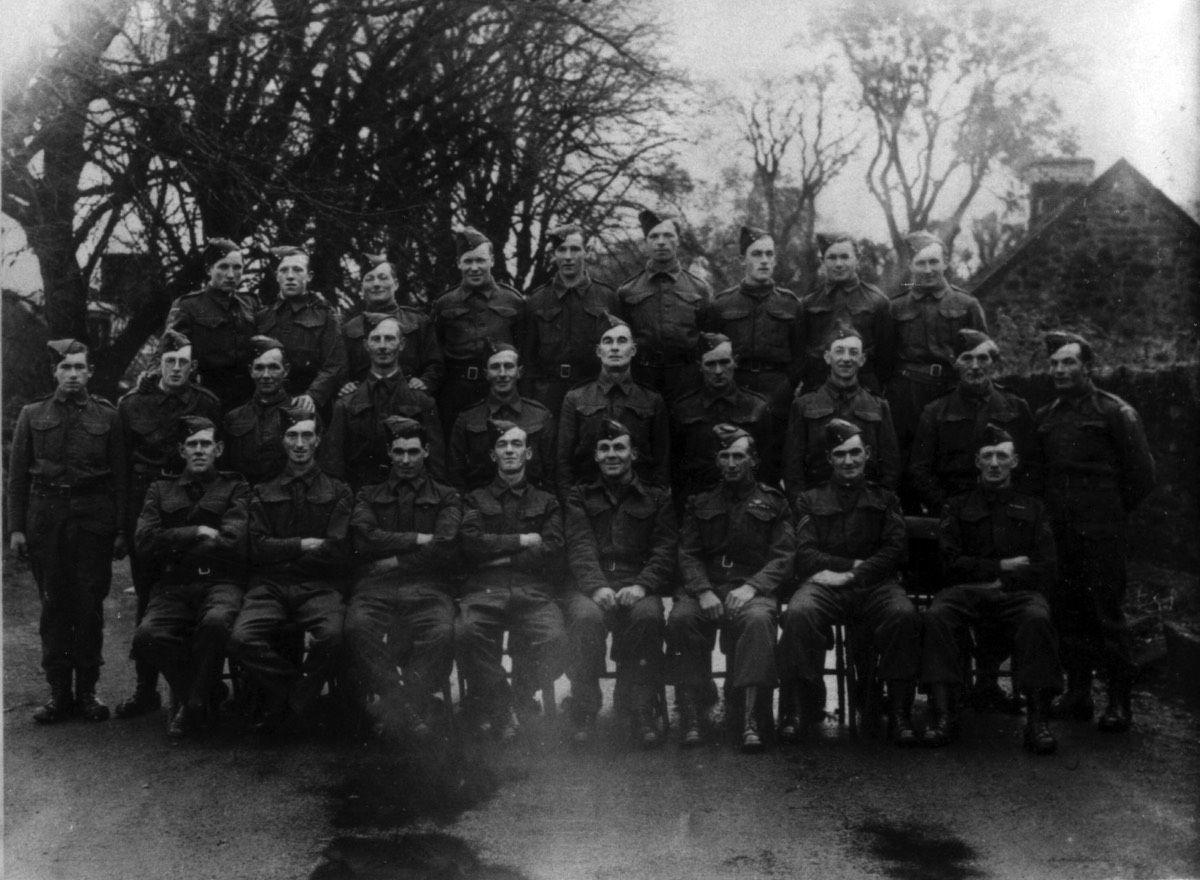
Innerwick Home Guard Unit in 1944.
The LDV
On 14th May 1940 the Secretary of State for War, Anthony Eden, broadcast an appeal on the B.B.C. Home Service for men who were either too old or too young to join the Regular Army, to join the Local Defence Volunteers (L.D.V.). This was a locally based formation being created to aid the Regular Army in the defence of the country at a pretty desperate time in its history. Nationwide there was no shortage of volunteers and a number of companies were established in East Lothian, including those at Aberlady, Broxburn, Macmerry and North Berwick. The L.D.V. was officially renamed the Home Guard (H.G.) on 23 July 1940.
In effect, the Home Guard was a force of part-time soldiers, including those who were too old for active service, those who were waiting to reach call-up age and those who, during normal working hours, worked in a whole range of reserved occupations. Many H.G. members in East Lothian were from farming communities or from a variety of rural occupations. In the evenings and at weekend these men came home, had their meals, donned their H.G. uniform and headed out to do whatever duty or training was theirs to do.
Early Days
By the 15th May 100 men had volunteered at North Berwick and fifteen in Gullane; by a week later the numbers had risen to 142 in North Berwick and 100 in Gullane. In fact, the number of men who came forward meant that it was equipment and weapons which were in short supply, not volunteers, and it was mid June 1940 before even uniforms became available. Following Dunkirk weapons were also very hard to come by but a supply of First World War rifles from the United States helped boost the motley collection of broom handles, pitch forks and antique hand-guns with which the L.D.V. had been initially equipped.
In East Lothian there were two Home Guard Battalions: First Battalion with its HQ at 1 Dirleton Avenue in North Berwick and Second Battalion with its HQ in Haddington. Both were affiliated to the Royal Scots (whose cap badge they wore) and were commanded by Lt. Col. Douglas J Blake and Lt. Col. Hon. HJ O’Brien respectively. A considerable proportion of the officers were farmers.
North Berwick Home Guard comprised two platoons: West platoon commanded by Lt. David Broomfield and East platoon commanded by Lt. Dan Wilkie. Both had their base and armoury in the Hope Rooms, North Berwick.
Matters Improve
The Home Guard’s manning of hastily constructed static defences, like Pill Boxes or road blocks, was made much more effective from late 1940 with the arrival of more and better weapons, such as Lewis machine-guns, Thompson sub-machine-guns, Mills Bombs (better known as hand grenades), Northover Projectors which could fire Molotov cocktails, and Spigot Mortars which were spring-fired anti-tank guns. Along with these weapons came increased stocks of ammunition. When the Home Guard started many members would have had no ammunition at all but by August 1943 it was estimated that Home Guard units in the Lothians and Peeblesshire held a total of almost half a million rounds of small arms ammunition, in the event an underestimate! The local Home Guard units also looked after the operation of the Flame Fougasses around the county.
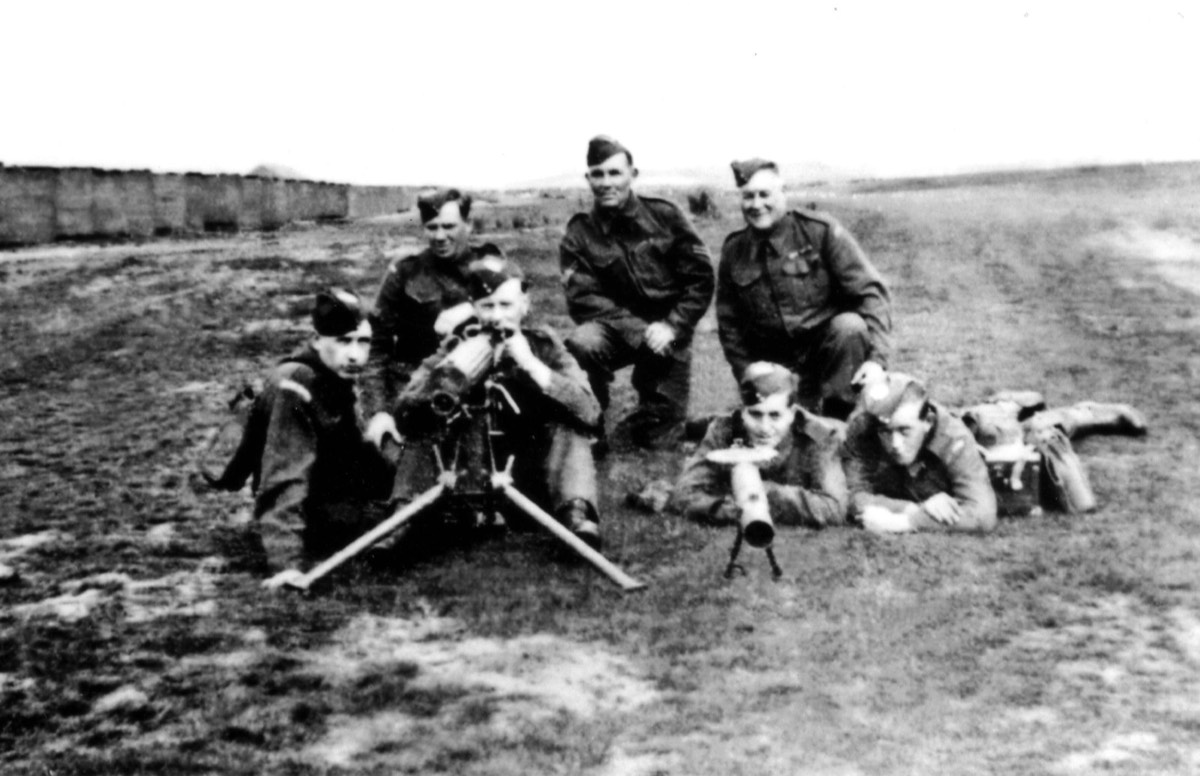
Stenton Home Guard Vickers machine gun and Lewis machine gun teams above and the same unit’s anti-tank gun team on the right.
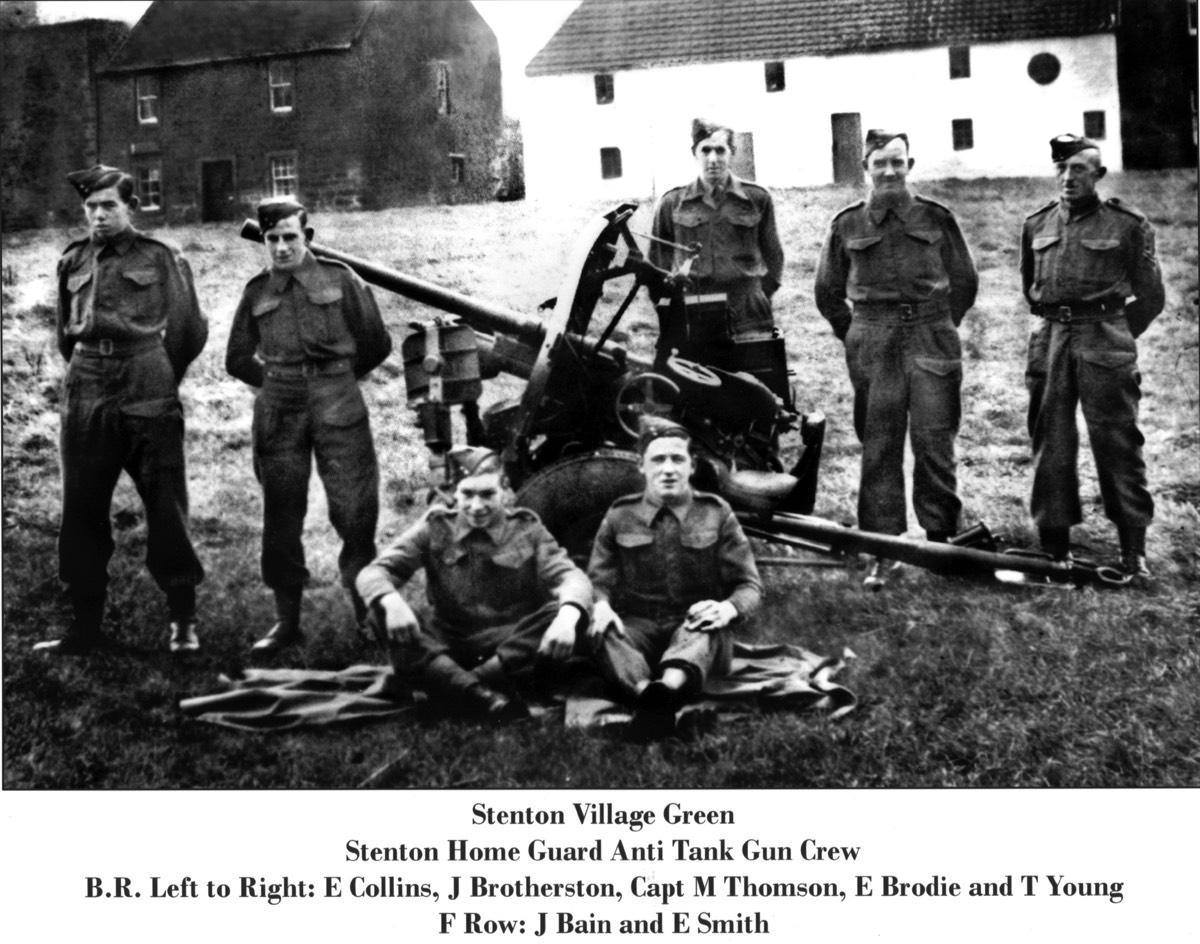
18pdr Field Guns
Wartime censorship was responsible for ‘hiding’ the fact that the Haddington Company of the Home Guard was one of the very few Home Guard units to be equipped with 18pdr Field Guns. The East Lothian Courier reported in October 1994 that fifty years before Haddington’s Home Guard company had been issued with the guns. The article explained that:
“It can now be stated that the Haddington Coy was one of the two Home Guard companies to be issued with 18 pounder field guns.
These were supplied to the Haddington unit in 1942 and since then the gunners have had to put in many hours work keeping the guns and making themselves efficient in their use.
Early this summer they secretly fired live ammunition for the first time in the Lammermuir Hills and on that occasion the men were congratulated on their performance.
This was all the reward the men asked for after their months of hard work, for they had practiced regularly two nights per week and every Sunday. On Sunday, the guns were again taken to the Lammermuir Hills for practice, when three of them fired off 150 rounds.
Lieut. McKenna demonstrated in no uncertain manner that since their earlier test his gunners of Haddington had improved their performance. All the members of the Home Guard deserve congratulations for their work – a great deal of it unacknowledged because of censorship regulations – which have been in force for the past four years.”
The East Lothian Courier.
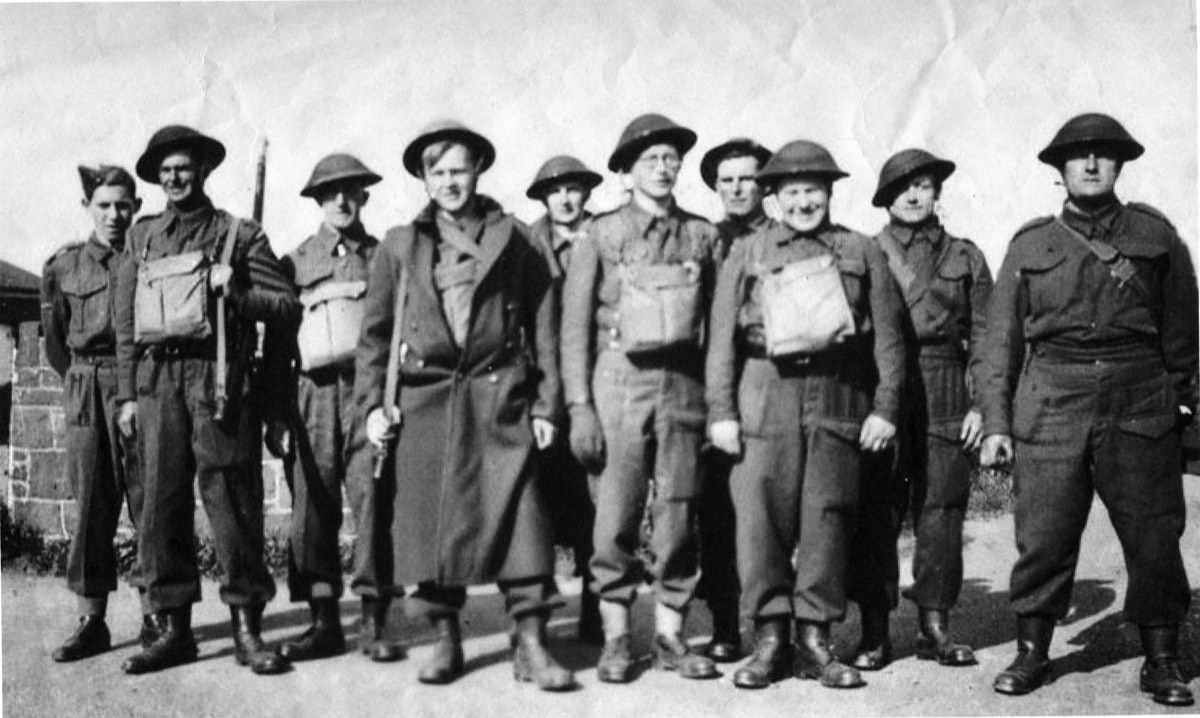
Haddington Home Guard. Fergus Main, the saddler, is third from the right.
Training
While preparing for an invasion that never came, much of the time spent by the members of the Home Guard was taken up with training. Such training required hard work and enthusiasm, both of which were in apparently plentiful supply. In September 1941 members of the 1st Battalion, East Lothian Home Guard, from Gullane, Dirleton and Aberlady held a weekend camp at the Hopes, near Gifford. Within a short space of time from their arrival in army trucks on the Saturday afternoon, tents had been erected, pits dug, a cook-house established, stores issued and they were ready for action. The afternoon and early evening were taken up by platoon exercises, patrolling, sending messages, communications, a talk on reconnaissance patrols by day and night, and in some ceremonial drill practice. The last activity was given particular emphasis when it was discovered that the camp was to be visited by a Field Marshall.
Home Guard exercises often tried to instil a measure of initiative in H.G. members. Platoon members were sent on exercises to test their skills and often those of the regular forces who also needed more realistic training. For example, on a number of occasions East Lothian H.G. units were set the task of breaking into East Fortune airfield to ‘blow up’ the aircraft there and the airfield guards given the reciprocal task of defence and prevention. All East Lothian H.G. units carried out regular exercises in the Lammermuir hills both by day and by night.
Here is a typical example from a private in the Home Guard of the range of exercises and training he could expect to undertake.
Feb. 6th
Feb. 20th
Feb. 27th
Feb. 29th
Mar. 5th & 12th
Mar. 19th
Mar. 26th
Apr. 2nd
Apr. 4th
May. 7th
May. 14th
May. 18th
June. 4th
June. 18th
July. 22nd
Standing to and Action Stations
Knowledge test and cartridging Spigot Mortar shells
First Aid demo
Fired Spigot Mortar
Ditto
Action Stations practice, grenade revision and test
Exercise - Spigot Mortar
Grenade test
A week’s course beginning with night training.
Exercise ‘Flanelette’.
Section in attack with live ammunition.
More night training.
Exercise ‘Airborne” - acted as ‘enemy’ so HG could mount a pincer attack
Taken by lorry and dumped twenty miles away. Dropped in threes and had to make our own way back
F Company attacked D Company
Demo of Spigot Mortar, sticky bombs and Hawkins Grenades
Lecture, rifle cleaning, bike test and run
Shooting on open range
Assault course
Inspection, bike test, range firing
Battalion exercise
Night Duty, rifle cleaning.
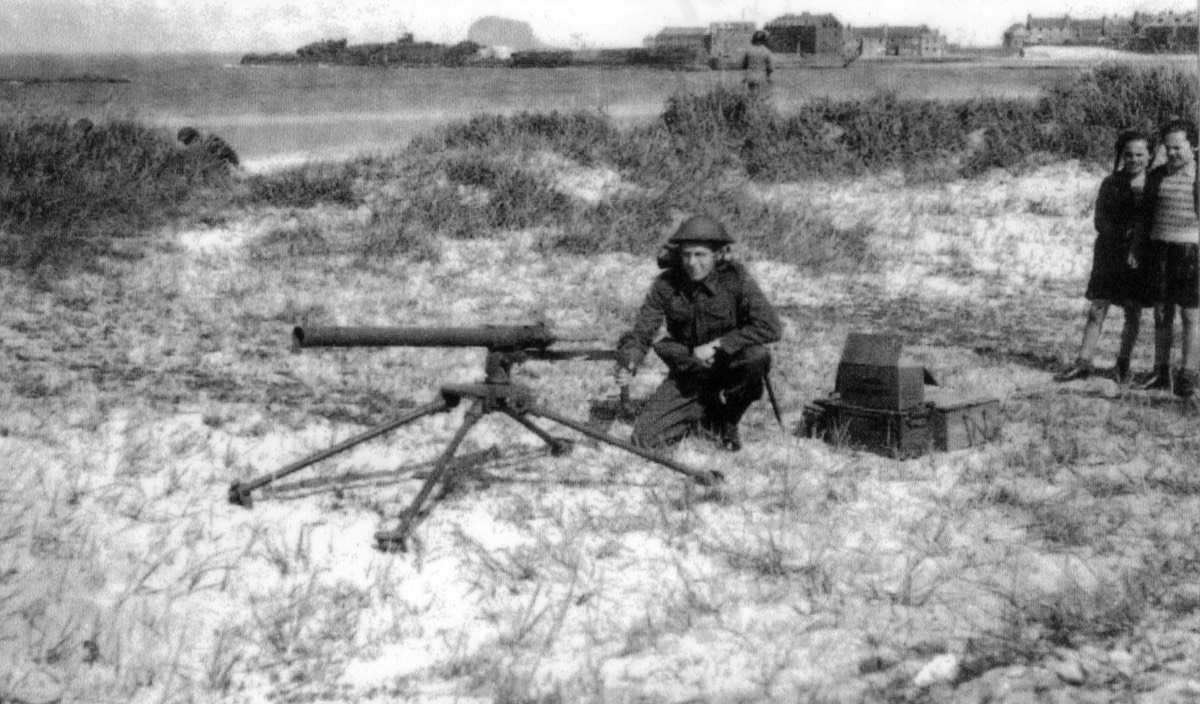
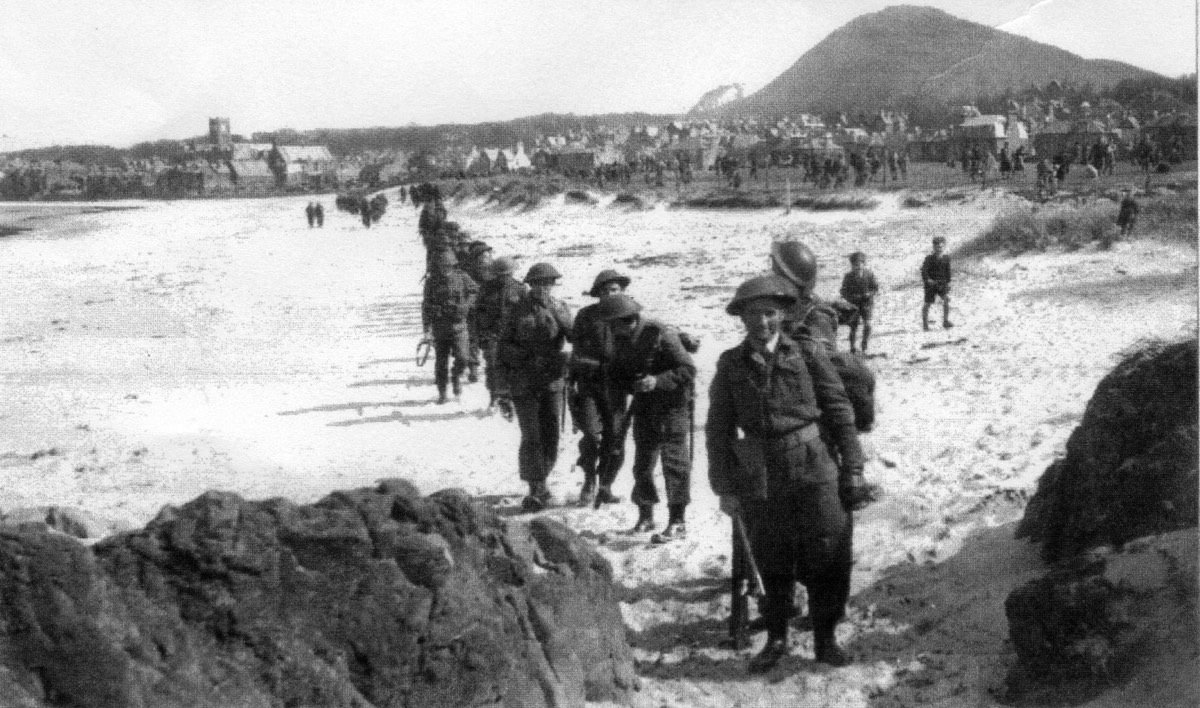
North Berwick Home Guard training near the town.
The Effectiveness Of The Home Guard
The BBC comedy ‘Dad’s Army’ has created the impression that the Home Guard would have been a poor match for an invading German army. While an element of truth lies in this observation (especially in the ill-equipped early days) the members of the Home Guard possessed a number of important advantages. Most importantly they knew the local countryside well - here many were local East Lothian farmers, ploughmen or gamekeepers - and thus would have been able to use the terrain to their advantage, placing roadblocks and obstructions in the most favourable locations. In addition many Home Guard soldiers were knowledgeable veterans of the 1914-18 war: one can see the medal ribbons on many a chest in the Home Guard unit photographs. There is little doubt that the Home Guard would have been able to delay the advance of German troops, probably at great cost to themselves, but hopefully until such time as mobile Regular Army reserves could stage a counterattack.
Stand Down
Stand down of the Home Guard finally came on Sunday 3 December 1944, with the need for a home defence of this nature clearly past. That day the East Lothian Battalion Home Guard held Stand Down parades across the county. For example, 'D' Company from Gullane were inspected by Colonel D. H. McCririck, Lothian and Borders Sub-Division Commander, and at 12.50 p.m. marched past the saluting base at the war memorial in the town, and into the history books as part of the preparations for the defence of Britain against an invasion which, thankfully, never came. It is a little known fact that the Home Guard across the UK lost 1,206 of its members to enemy bombing, strafing and training accidents. Some 557 were injured. Proof, were proof needed, that this was no ‘Dad’s Army’ but a very real attempt to provide a locally based defence force at a time of great danger.

East Lothian Home Guards march through North Berwick on 3rd December 1944 ‘Stand Down’ parade.
Recollections Of The Home Guard In The Lammermuirs
Mrs. Mary Stenhouse, a schoolchild living in the valley now occupied by the Whiteadder Reservoir, recalls:
"The War Office decided we should have a branch of the Home Guard in the glen, so the Marquis of Tweeddale came as commander or whatever to organise the men. One young man had a motorbike so he was immediately elected dispatch rider. The school-headmistress's husband was a retired gamekeeper so he was put in charge of the one gun: a double-barrel shotgun belonging to the Marquis. Various pieces of uniform were issued to whoever fitted them, though everyone got a tin hat. A bonfire was built on Priestlaw Hill to be lit in case of invasion.”
“One older gentleman was stationed beside the one telephone in the glen. Early one Sunday morning his grandson came knocking at the window saying the invasion was expected any moment, whereby my father and the young shepherd who lodged with us went back to bed till their normal rising time. My father and the old gamekeeper with the one gun were to go on watch on Priestlaw Hill at 11.00 a.m., so after a quiet wander up the hill, they lay down in the shelter of a stone wall and lit their pipes to await the call to arms. An old cock grouse landed on the wall and perched there looking about, so the old man pointed the gun saying, "Man, John, what a grand shot that would be," at which my father told him not to fire or the whole of the south of Scotland would think the invasion had begun!"
Mrs. Mary Stenhouse
Recollections Of The Home Guard At Gleghornie, A Farm Near North Berwick.
Written by Leila Reynard (née Shepherd)
“All men who worked on the farm were Home Guards. Having worked a six-day week they were on parade on Sunday, the seventh day of the week. My father, Thomas Shepherd, was the Lieutenant. Paddy Duggan, an Irishman who lived in the Bothy, having served in World War One, was the Sergeant. During the week whilst working on the farm he was at the lower end of the social scale. On Sundays, with his Sergeant’s stripes, he was the top! The men took their duties very seriously. One exercise that I was told about involved the Gleghornie Platoon getting through a heavily guarded area (held by the North Berwick Home Guard) to reach a rendezvous beyond. The Gleghornie Guards lay down in a hay-cart, pilling lots of hay on top. One Guard had his farm working clothes on and he sat in the front of the cart while the Clydesdale horse plodded to the check out. He was waved on! They got through and the Gleghornie Home Guards ran back with their guns saying ‘Bang, bang! You’re dead!’”
Leila Reynard (née Shepherd)
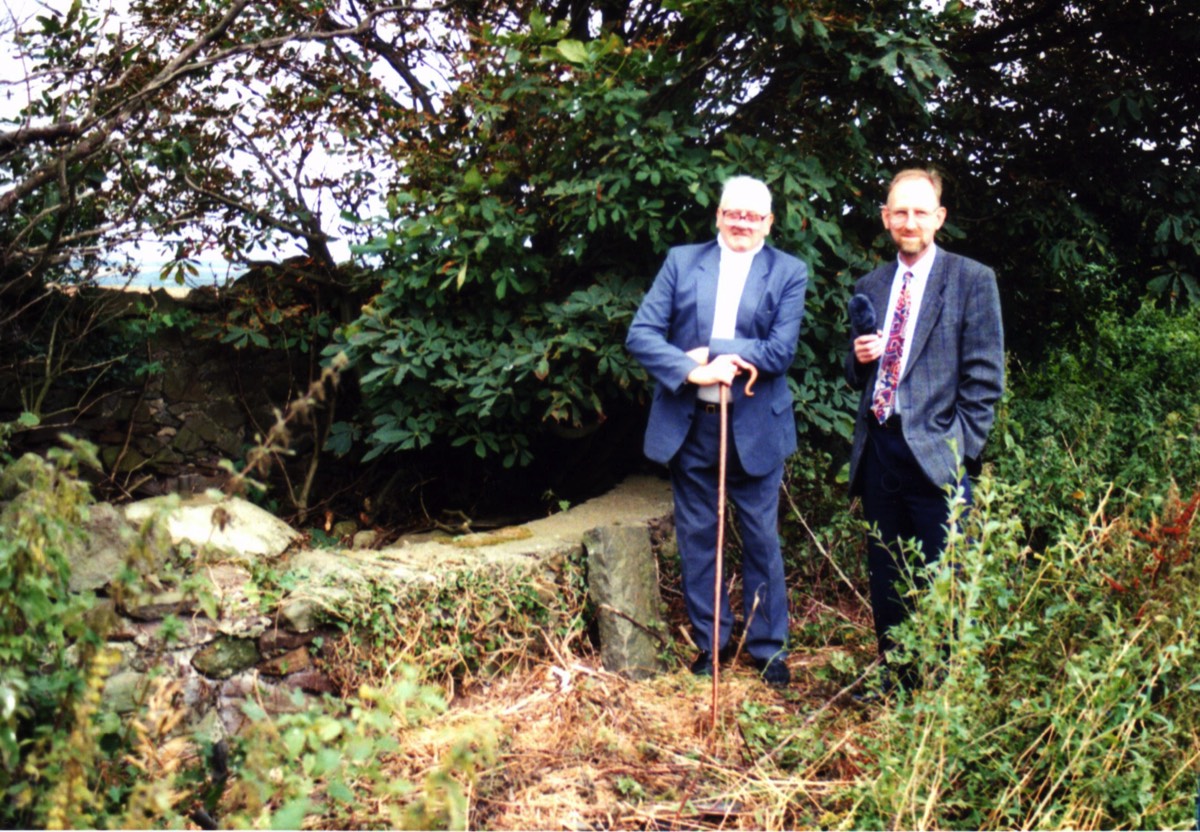
Andrew Ross (left) by the Spigot Mortar mount at the top of Pencraig Hill.
Andrew Ross
Andrew served in the East Linton Home Guard and, when he was interviewed at the top of Pencraig Hill on the old A1 above East Linton, described his time in the force. He said that he’d only fired one live round from a Spigot Mortar on a mortar range in the Lammermuirs though he had fired a couple of dummy rounds. Andrew had joined the Home Guard when he was sixteen and a half but had only run messages and appeared on parade. He’d only been given his rifle, ammunition and uniform when he reached seventeen in 1941. He had served till the force was disbanded in 1944.
Andrew told how there was about 100 men in the East Linton Home Guard because “...there was an Auxiliary unit and another to look after the railway and the station. We had nothing to do with them.” He said that, “...we’d the same kind of cock-ups [as in Dad’s Army] but, of course, it was all taken very seriously. You had to take it seriously when you were the last line of defence. Mind you, we had our amusing moments. I remember one exercise when we were given orders to try to break into East Fortune airfield to give the RAF Regiment some practice. I was called everything in the book because I knew a back way in that the Air Force used as a shortcut and I led my section in there and got in behind them and caused all sorts of ... . It wasn’t in the rules of the game. ‘Fortunes of war’, I said! They all took it in good part but my sergeant asked me what I thought I was doing.”
Andrew took part in many exercises. He described one:
“A Section might be sent out early in the morning and we were sent to try to catch them, pretend they were the enemy, throw chalk grenades at them and such like.”
Home Guard At Tor Bridge, Near Innerwick
These two pictures show a re-creation, based upon an eyewitness description, of how the Home Guard might have looked when preparing to blow up Tor Bridge near Innerwick to deny it to the enemy.
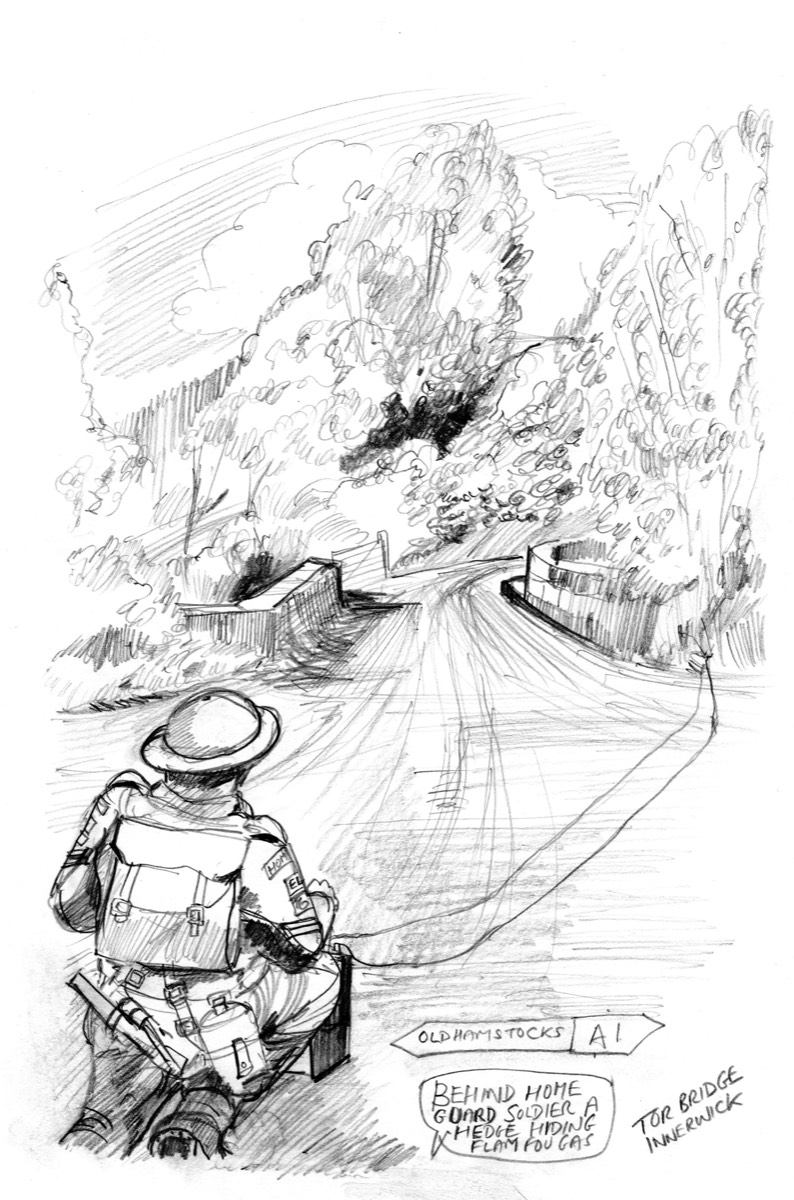
While these pictures are quite realistic one would have to assume that the members of the Home Guard would have paid greater attention to staying under cover in a real-life situation!
The eyewitness also alluded to the presence of a
Flame Fougasse at this site.
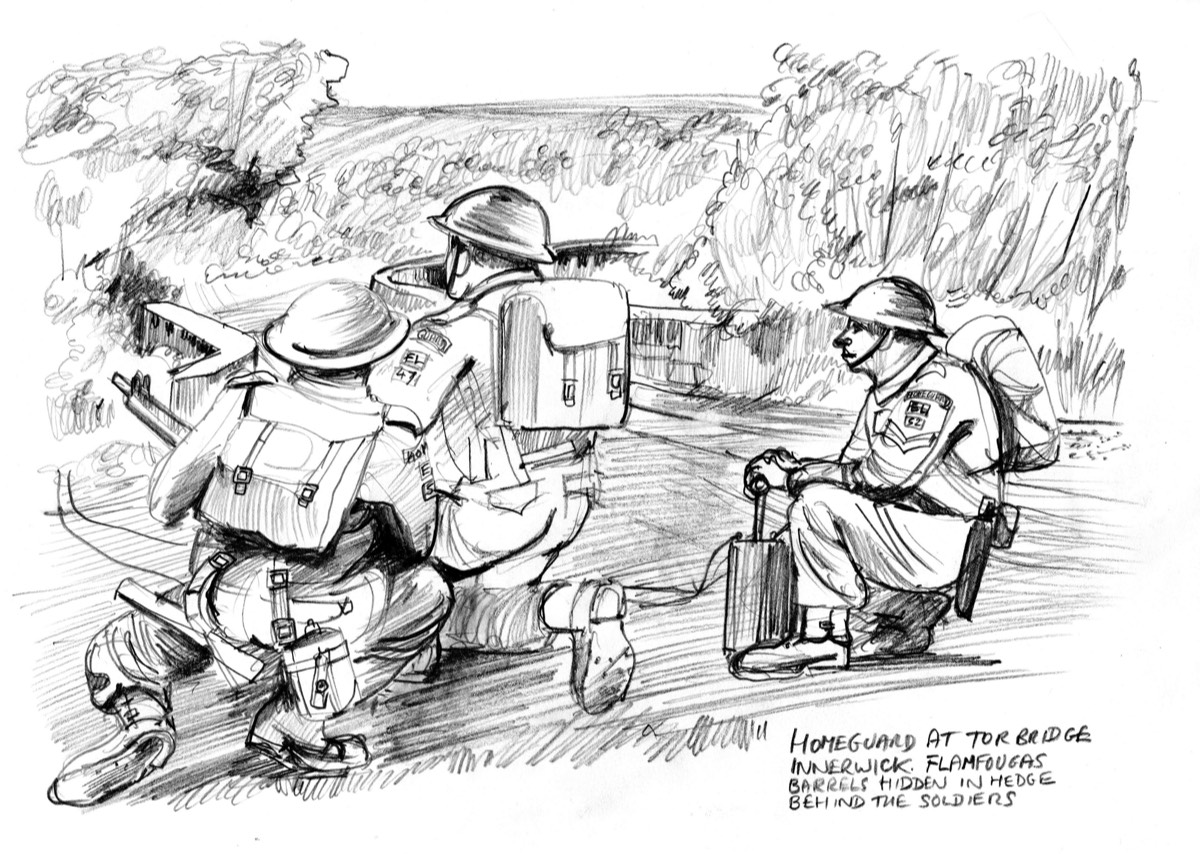
Artist: Stuart Carruthers
Newfoundland Overseas Timber Corps And East Lothian Home Guard
See section ‘Home Front’ and ‘Timber Corps’
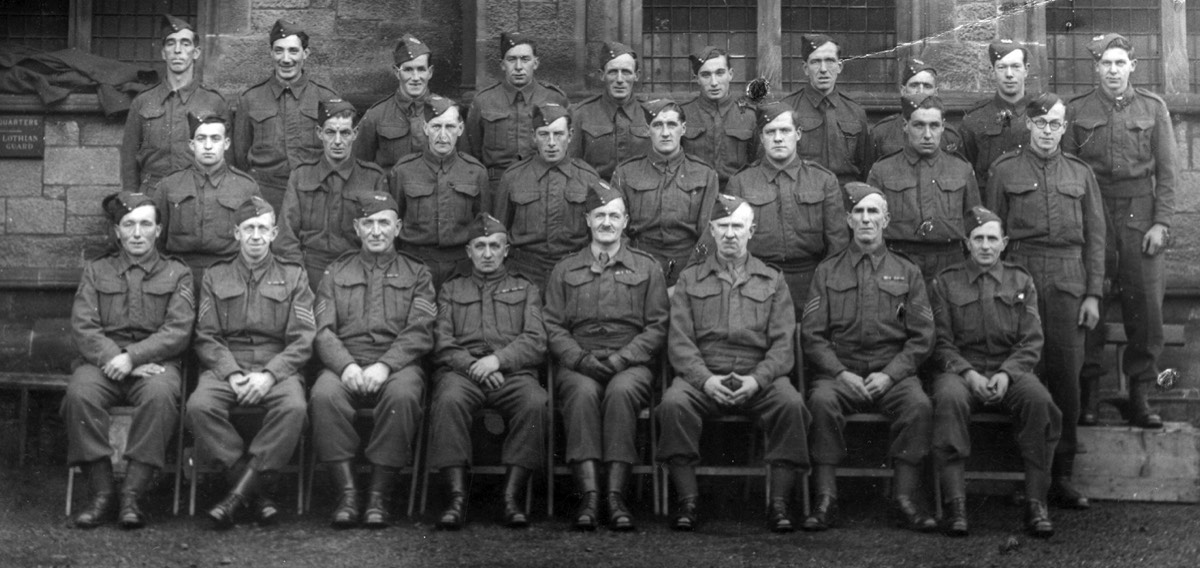
East Saltoun Home Guard
I am indebted to David Scott, formerly farmer at Howden, for many of the following identifications and background information:
Back Row: L>R - RT Cornwall (worked Saltoun East Farm); Johnnie Hamilton (worked on the farm at Samuelston South Mains during the war then moved to Gilchriston Farm); Jimmy Millar (worked at the Lime Kilns along the Gifford Road. Played the fiddle at some of the social evenings in the village hall); Alec ‘Ec’ Stenhouse (worked at Howden Farm); William Hastie (worked at Howden farm); Tommy Dickson (later worked at Lennoxlove); Bob Punton; David Wilson; B. Dickson; Jim Tait (son of Tom Tait who farmed at Greenlaw Farm).
Middle Row: L>R - Unknown; Peter Wilson (Worked at Greenhead at one time. Known as ‘Pete the Dabber’); Tom Peacock (was originally from Ormiston but lived in East Saltoun. He had been a coalminer but had to give up work due to a lung disease which was common among miners); George Watt; Oliver (Ollie) Main (Worked at Middlemains Farm. His father Jim was Farm Manager at Saltoun Home Farm); Adam Maxwell (farmed at Cauldshiel with his brother John); J. Turner; Roy Tait (brother to Jim Tait from Greenlaw).
Front Row: L>R - Jim Buglass (worked on the farm at East Saltoun. He was beadle in the church for a long number of years); Jimmy Houliston (was grieve at Greenhead ); Jim Baptie (was the Head Gamekeeper on Saltoun estate for Captain Fletcher.); Robert (Bobbie) Watson (foreman at East Saltoun farm and was awarded the Military Medal during his service in the First World War. He went with Fred Durie and held the horses while they were being shod after he retired); Peter Prentice (was also in the First World War and was schoolmaster at Saltoun School); Fred Durie snr (was the village blacksmith for many years. He made his own headstone which can be viewed in Saltoun churchyard); Stewart Addison (worked on the Saltoun estate, perhaps as a forrester); Nicol Hislop (farm manager at Samuelston South Mains, farmed at that time by Miss Cadzow).
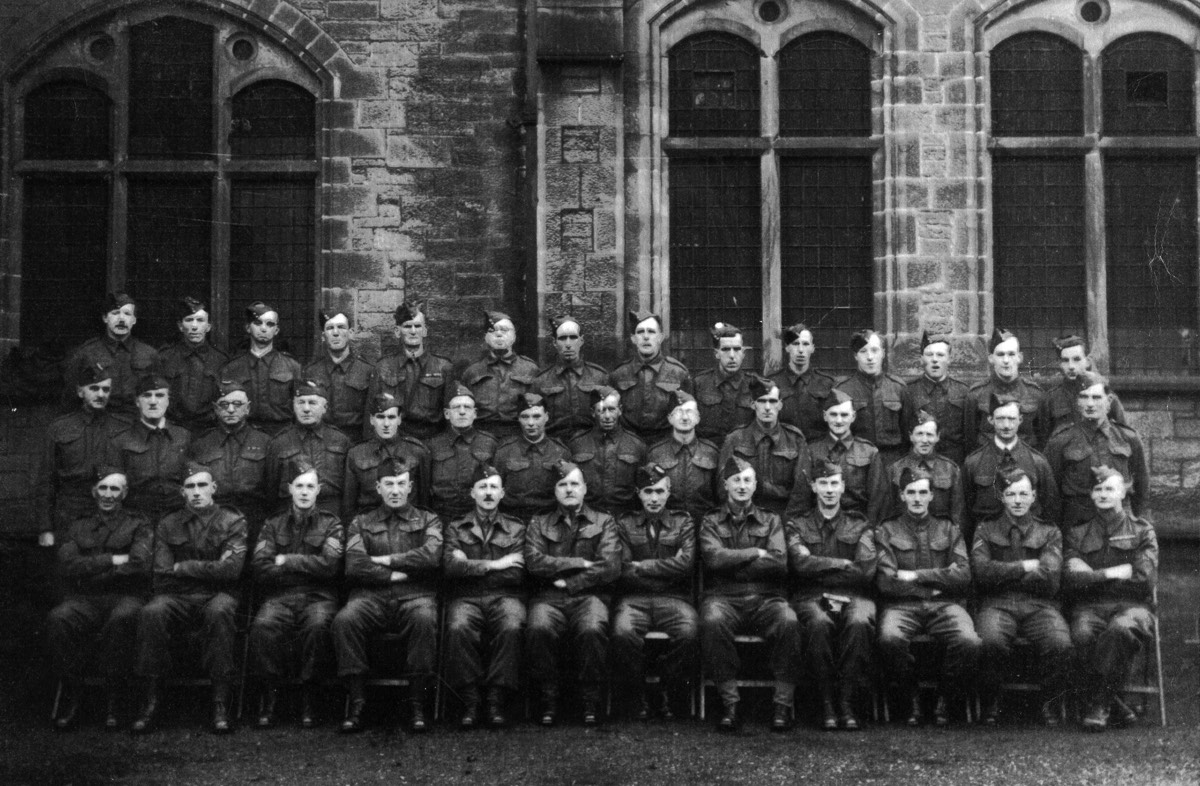
Longniddry Home Guard Unit - Names Thanks To Jim O’Donnell
Back Row: L>R - David Douglas, Ben Mackintosh, Tom Greenlaw, John Paxton, ? Campbell, Bruce Johnston, ??, Peter Scott, ?? , Jim O’Donnell, Andrew Honeysett, Walter Montgomery, Bob Porteous and Jack Buxton.
Middle Row: L>R -? Oliver, Peter Sanderson, Roy Cutter, John Howie, Gordon Morrison, ??, Bill Skane, John McRaw, Claude McDougal, ??, ? McLeod?, Harry O’Neil, Peter Dickson, ??.
Front Row: L>R - Henry Barry, Jack Black, Willy McLeod, Jack Park, George Walls, Russell Patrick, Archie McLelland, Frank Smith, Davie Park, John Brown, Dave Morris and Alex Florrence.
Jim O’Donnell - One Longniddry Home Guard Member’s Story
I interviewed Jim on the 23rd February, 2017. What follows is his own story-
I left school in July 1939 and worked with my father in his market garden. I was given a nine-inch hoe and told to weed a field of beetroot and that quickly convinced me that my future didn’t lie in a market garden. I left and became an apprentice in Glencairn Coal Mine, aged sixteen. I gravitated towards the engineering side of mining. In 1944 I was invalided out of the mines and after recovery I was directed by the Ministry of Labour to work for Alexanders of Edinburgh as an engine fitter.
I joined the Home Guard for no particular reason other than that everyone else was. I was too young for the army but was interested in flying and I and a pal, Harry McConnell, cycled to Edinburgh to try to join the Royal Air Force. Much to my disappointment I was refused entry to flying crew for medical reasons. Harry joined as Ground Crew.
I began life in the Home Guard in civvies: uniforms came later. Much the same applied to the weaponry the platoon possessed. It all came from guns owned by members or scrounged from locals and mainly comprised shotguns plus one elephant gun. Jim never fired the latter nor saw it fired! The first issue of rifles was of Canadian Ross type. In 1940 the unit was supplied with American .300 rifles and these were used throughout the war. British ammunition (.303) couldn’t be used and, anyway, supplies were so limited that each man only had five rounds in his possession. Quite a number of lethal .22 rifles appeared and, remarkably, a bow and its arrows which, in the right hands, was lethal. In 1941, after the Dunkirk days of the war were past, the unit was supplied with Lewis guns and I became a Lewis gunner. It was a damned heavy weapon despite being striped down aircraft guns. Browning automatics also arrived. The unit’s transport was a Fairgrieves coal lorry. The Home Guard members used to come away all black from the coal dust!
While hindsight would tend to reduce the likelihood of East Lothian being invaded in 1940, the fear of such was very strong at the time. It was thought invasion was possible from Norway and the county’s defences reflected such fears.
Longniddry’s Home Guard was based in Longniddry Golf Club clubhouse: a location that gave a good all-round view of the surrounding countryside. Sunday was a regular training day and I was on sentry duty in the clubhouse during the 1940 invasion scare. I worked a two hours on and four hours off routine and once was nearly injured or killed when a member of the platoon accidentally fired a gun in the clubhouse and the bullet passed through the floor (now in the office) just passing my head as I lay in a bunk, resting. Of course, like all Home Guard members, I carried on with my daytime job, one which involved shift work and often included weekend maintenance.

Jim’s ‘Home Guard’ mug.
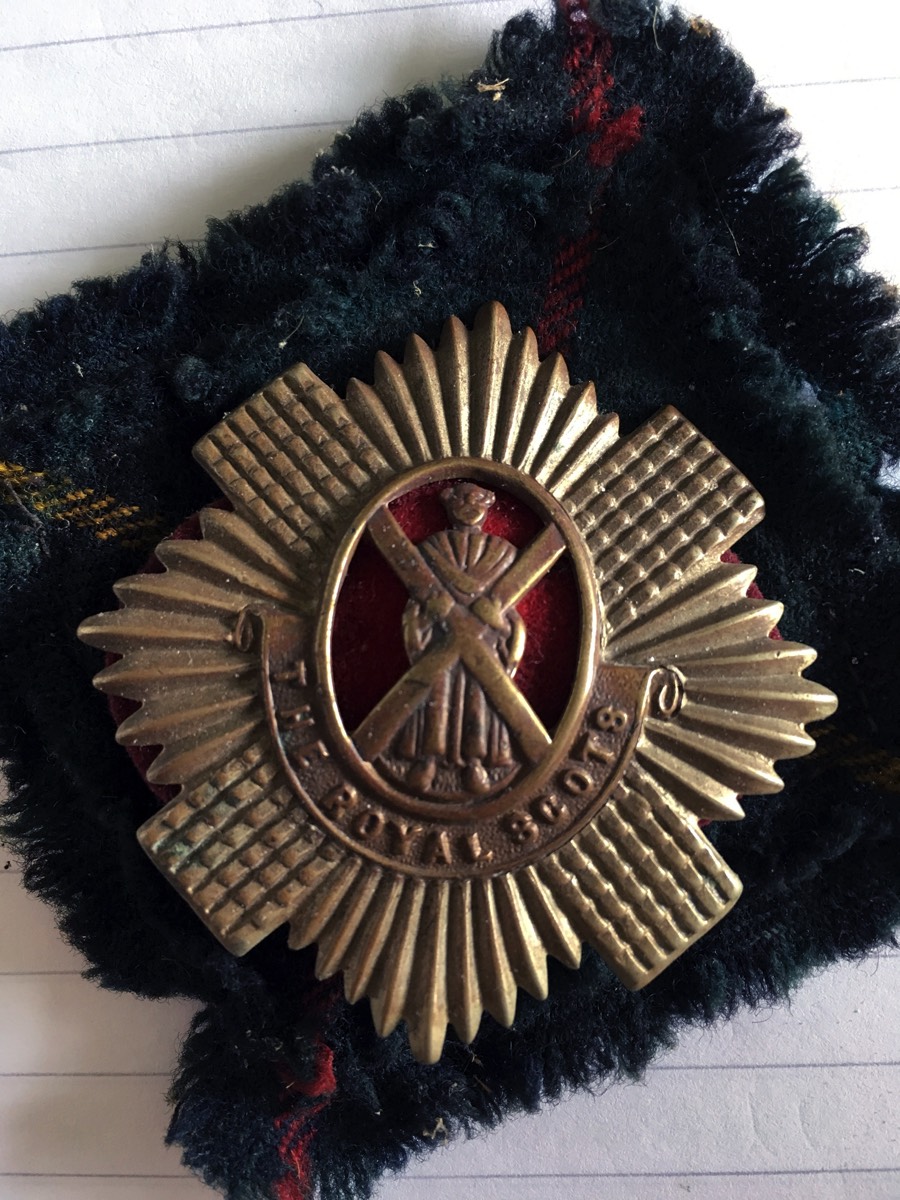
Jim’s 2nd Batt. Royal Scots cap badge.
In demonstration these weapons were a danger to their operators. The Flame Fougasse opposite Longniddry station was tested and set fire to the fence opposite. The tank was in the trees and the piping can still be seen in situ. The flame thrower comprised a forty-gallon tank filled with a petrol/diesel mix and was powered’ by a nitrogen bottle. On one occasion I operated the valve while two others held a long armoured hose but, when tested, the hose became so hot that the operators dropped it and it sprayed a jet of burning fuel all around, nearly incinerating the Top Brass there to watch. It wasn’t used again!
As far as the western part of East Lothian was concerned, there were Home Guard units in Preston Links and Prestongrange, in Macmerry, Tranent, Prestonpans and in Musselburgh and Levenhall. I remember some of the characters in the Longniddry unit, such as Jock Stewart who amused all and sundry with his imitations of Winston Churchill. Two members were, almost unbelievably, one-legged: Donald Fraser, a cobbler, and Jock Stewart himself. Lots of ex-servicemen belonged to the unit, often men who had served in the First World War . This was partly due to the presence of such men in Kitchener Crescent, housing built to house ex-servicemen after the First war. The Home Guard in the area were attached to the Second Battalion Royal Scots and wore the Royal Scots badge with Tartan hackle.
As well as patrolling and being on sentry duty, the platoon manned roadblocks in the area. I enjoyed the weekend camps: they were great fun though, obviously with serious intent. They were sometimes held in the Hopes valley. Like other Home Guard members in other platoons across the county, I knew my area inside out. We walked, skirmished and trained over it as well as possessing the knowledge gained from living in it from childhood. I used to use the rifle range at East Saltoun where we practised how to throw grenades and fire mortars. An instructor lost an arm to an anti-tank mine that exploded prematurely. Explosives were part and parcel of my wartime experiences in the Home Guard and many of the Longniddry platoon, who could be quite wild men and who, as miners, had ready access to explosives, used to come on duty with their pockets filled with them! We all took our rifles home after we went off duty.”
I raised the subject of the BBC’s Dad’s Army and its humorous portrayal of the Home Guard. He replied:
It was all very serious and I believe that if Germany had come we would have been annihilated, though we might have taken a lot of the enemy with us."
Jim O’Donnell

